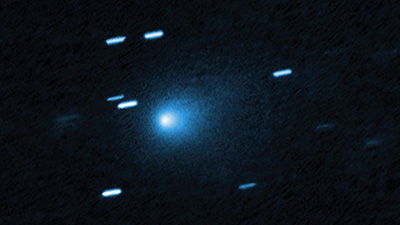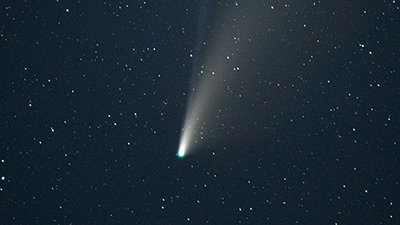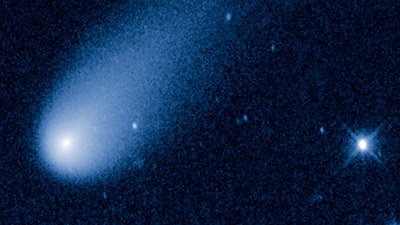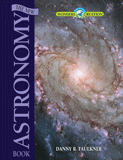Comets
Comet with Asteroid-like Composition Discovered by NASA
At least one comet isn’t quite what astronomers expected, based on the results of NASA’s Stardust mission. Although Wild 2 orbits like a comet, a chemical analysis by scientists indicates that the comet’s composition is asteroidal, resembling objects from the inner solar system’s famous asteroid belt rather than “pristine and ancient materials expected to be deep-frozen in the much more distant Kuiper Belt.”
Short-Lived Comets
A comet spends most of its time far from the sun in the deep freeze of space. But once each orbit a comet comes very close to the sun, allowing the sun’s heat to evaporate much of the comet’s ice and dislodge dust to form a beautiful tail. Comets have little mass, so each close pass to the sun greatly reduces a comet’s size, and eventually comets fade away. They can’t survive billions of years.
Did Comets Have a Role In Forming Earth’s Oceans?
Kuiper comets capture credit for watering the early Earth. Evolutionary scientists believe that water was needed for the evolution of life but have long debated how the early earth could have been supplied with that water. Now a team from the Max Planck Institute for Solar System Research, analyzing data from the Herschel Space Observatory, has determined that comets from the Kuiper belt may have been that ancient source.
Articles About Comets
-
Nov. 29, 2025 from Answers in Depth
What is 3I/ATLAS, will it collide with earth, and is it an alien spacecraft?
-
Sept. 17, 2022 from Answers Magazine
Most evolutionary astronomers talk about the Oort cloud like it’s a fact. Yet they admit no direct observational evidence exists.
-
Aug. 22, 2021 from Answers Magazine
Comets can’t survive billions of years.
-
Eyes on Comet ISON’s Fiery Fate but Not Oort OriginsNov. 30, 2013 from News to Know
Comet ISON’s fate fuels speculation about its origins. Since comets simply cannot survive for millions of years, where could new comets come from?
-
Feedback ArticleFeedback: Assuming the Origin of CometsNov. 15, 2013 from Feedback
Dr. Danny Faulkner identifies how different assumptions provide different explanations of the origin of comets.
-
Oct. 1, 2013 from Answers Magazine
This December the heavens will put on another spectacular show.
-
Sungrazing Comet for ChristmasDec. 15, 2012 from News to Know
Sungrazing comet promises a great show for Christmas 2013.
-
Comets Had a Role In Forming Earth’s Oceans, Study ShowsOct. 15, 2011 from News to Know
Kuiper comets capture credit for watering the early Earth.
-
Nemesis Comet Most Likely a MythAug. 13, 2011 from News to Know
Have no fear: the death star is not there.
-
Could a Comet Construct Life on Earth?Sept. 18, 2010 from News to Know
Could the destructive impact of a comet construct life on earth?
-
Comet with Asteroid Build Discovered by NASAFeb. 2, 2008
At least one comet isn’t quite what astronomers expected, based on the results of NASA’s Stardust mission.
-
Comet-Based Life?Aug. 18, 2007
A team of astrobiologists claim that “it is one trillion trillion times more likely that life started inside a slushy comet than on Earth.”
-
Magazine Department ArticleA Comet’s TaleJuly 23, 2007 from Answers Magazine
You may have seen the footage of the S-W 3 comet breaking apart, but it’s doubtful that you heard anything about its implications for evolutionary beliefs.
-
Another Comment on the CometMay 11, 2006
Last weekend, in a historic astronomical event, fragment C of comet Schwassmann–Wachmann 3 passed by the famous Ring Nebula (M57).
-
The Tale of a CometMay 6, 2006
A camera on the Hubble Space Telescope has recently captured remarkable images of a comet breaking apart. This event has something important to say about the age of the solar system.
-
Cosmic Fireworks on the Fourth of July!July 2, 2005
The "Deep Impact" spacecraft of NASA is scheduled to rendezvous with Comet Tempel 1 this Fourth of July.
-
Semi-Technical Research PaperKuiper Belt Objects: Solution to Short-Period Comets?Aug. 1, 2002, pp. 15–17
Recently, astronomers have discovered that several KBOs (‘Kuiper Belt Objects’) are binary—they consist of two co-orbiting masses. What are the implications for Creation?
-
Semi-Technical Research PaperMore Problems for the ‘Oort Comet Cloud’Aug. 1, 2001, pp. 11–12
Comets are continually being lost through decay, collisions with planets, and ejections from the solar system. If the solar system were billions of years old, then all comets would have died long ago.
-
Technical Research PaperComets and the Age of the Solar SystemDec. 1, 1997, pp. 264–273
The existence of comets as an argument for a recent creation is examined.
Recommended Resources

Answers in Genesis is an apologetics ministry, dedicated to helping Christians defend their faith and proclaim the good news of Jesus Christ.
- Customer Service 800.778.3390
- Available Monday–Friday | 9 AM–5 PM ET
- © 2026 Answers in Genesis







